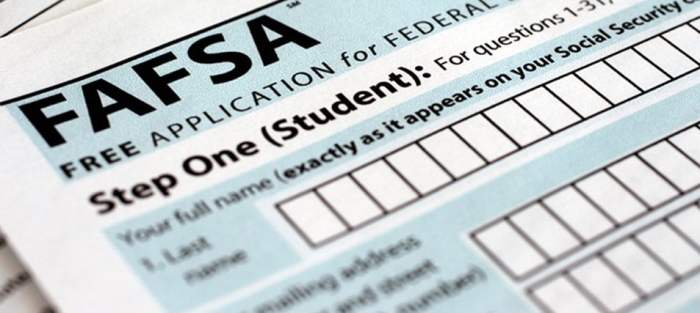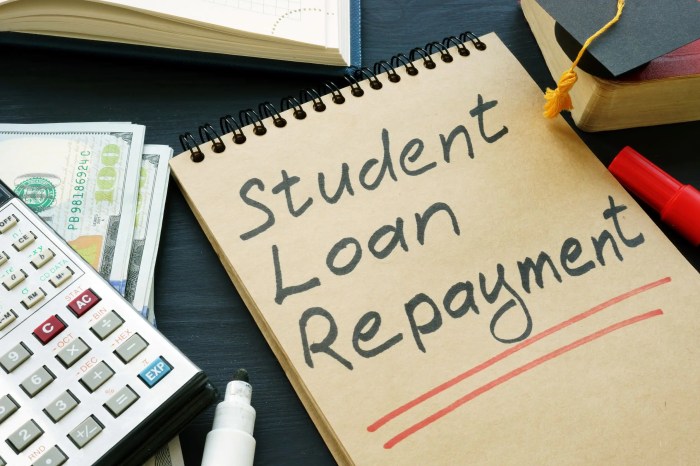
Navigating the complexities of student loan repayment can feel overwhelming, but understanding your options and developing a strategic plan is key to financial freedom. This guide demystifies the process of repaying FAFSA loans, offering a clear path toward managing your debt effectively and achieving your financial goals. We’ll explore various repayment plans, budgeting strategies, and resources available to help you tackle your student loan debt successfully.
From understanding the difference between FAFSA application and the loans themselves to exploring loan forgiveness programs and refinancing options, this comprehensive guide provides the knowledge and tools you need to confidently manage your student loan repayment journey. We’ll cover everything from completing the FAFSA form correctly to choosing the best repayment plan for your individual circumstances and navigating potential financial hardships.
Understanding FAFSA and Student Loans
Navigating the world of higher education funding can be complex, but understanding the roles of the FAFSA and student loans is crucial for prospective students and their families. This section clarifies the differences between these two key components and provides a guide to successfully applying for federal student aid.
FAFSA and Student Loans: Key Differences
The Free Application for Federal Student Aid (FAFSA) is a form used to determine your eligibility for federal student aid, including grants, work-study programs, and loans. It is not a loan application itself. Student loans, on the other hand, are the borrowed funds you receive to help pay for college expenses. Completing the FAFSA is a necessary first step to access federal student loans, but they are distinct processes. The FAFSA assesses your financial need; the loan application process determines the amount you can borrow and the terms of repayment.
Types of Federal Student Loans
The federal government offers several types of student loans with varying interest rates and repayment terms. These loans generally offer more favorable terms than private loans. Understanding these options is key to choosing the best fit for your financial situation.
- Subsidized Loans: The government pays the interest while you’re in school at least half-time, during grace periods, and during periods of deferment. This means your loan balance doesn’t grow during these times.
- Unsubsidized Loans: Interest accrues (accumulates) from the time the loan is disbursed, regardless of your enrollment status. You are responsible for paying this accumulated interest.
- Direct PLUS Loans: These loans are available to graduate and professional students and parents of undergraduate students. Credit checks are typically required, and borrowers are responsible for all interest that accrues.
Completing the FAFSA Form: A Step-by-Step Guide
The FAFSA application process is straightforward, but careful attention to detail is essential. The following steps Artikel the key stages involved:
- Gather Necessary Information: Collect your Social Security number, federal tax returns (yours and your parents’, if applicable), W-2s, and other relevant financial documents.
- Create an FSA ID: You and your parent(s) (if applicable) will need an FSA ID to access and sign the FAFSA online.
- Complete the Online Application: Carefully answer all questions accurately and completely. Use the IRS Data Retrieval Tool to automatically transfer tax information, minimizing errors.
- Review and Submit: Thoroughly review your application for accuracy before submitting it. Ensure all information is correct.
- Track Your Application Status: Monitor your application status online to ensure it’s been processed and that you’ve received your Student Aid Report (SAR).
Common FAFSA Application Mistakes to Avoid
Several common mistakes can delay or jeopardize your FAFSA application. Avoiding these errors will ensure a smoother process.
- Inaccurate Information: Providing incorrect information can lead to delays or denial of aid. Double-check all entries for accuracy.
- Missing Documents: Ensure you have all necessary documents before starting the application.
- Late Submission: Submit your FAFSA as early as possible to avoid missing deadlines.
- Failing to Sign: Both you and your parent(s) (if required) must electronically sign the FAFSA.
Federal Student Loan Repayment Plans
Choosing the right repayment plan significantly impacts your monthly payments and overall repayment costs. Understanding the different options is crucial.
| Repayment Plan | Payment Length | Monthly Payment | Total Interest Paid |
|---|---|---|---|
| Standard Repayment Plan | 10 years | Varies based on loan amount and interest rate | Generally highest |
| Graduated Repayment Plan | 10 years | Starts low, increases over time | Generally high |
| Extended Repayment Plan | Up to 25 years | Lower monthly payments | Generally highest |
| Income-Driven Repayment (IDR) Plans | Up to 20-25 years | Based on income and family size | Potentially lower, but depends on income and loan amount |
Repayment Options for FAFSA Loans

Choosing the right repayment plan for your federal student loans is crucial for managing your debt effectively. Different plans offer varying monthly payment amounts and total repayment periods, impacting your long-term financial health. Understanding the advantages and disadvantages of each option will help you make an informed decision.
Standard Repayment Plan
The standard repayment plan is the default option for most federal student loans. It typically involves fixed monthly payments over a 10-year period. This plan offers predictability in monthly expenses but may result in higher monthly payments compared to other options.
Graduated Repayment Plan
The graduated repayment plan starts with lower monthly payments that gradually increase over time. This can be beneficial in the early stages of your career when income is typically lower. However, payments can become significantly higher in later years, potentially causing financial strain.
Extended Repayment Plan
This plan extends the repayment period to up to 25 years, significantly lowering monthly payments. However, the extended repayment period leads to paying substantially more interest over the life of the loan.
Income-Driven Repayment Plans
Income-driven repayment plans (IDRs) link your monthly payments to your income and family size. Several IDR plans exist, including the Income-Based Repayment (IBR), Pay As You Earn (PAYE), Revised Pay As You Earn (REPAYE), and Income-Contingent Repayment (ICR) plans. These plans typically offer lower monthly payments, especially during periods of lower income. However, the extended repayment periods often result in higher overall interest paid. Eligibility requirements vary depending on the specific plan.
Comparison of Repayment Plans
The following table summarizes the key differences between the repayment plans:
| Repayment Plan | Payment Amount | Repayment Period | Total Interest Paid |
|---|---|---|---|
| Standard | High, fixed | 10 years | Lower |
| Graduated | Low initially, increasing | 10 years | Moderate |
| Extended | Low | Up to 25 years | High |
| Income-Driven | Variable, based on income | Up to 20-25 years | High |
Choosing a Repayment Plan: A Decision-Making Flowchart
The following flowchart Artikels a simplified decision-making process for choosing a repayment plan. Note that individual circumstances will influence the best option.
(Imagine a flowchart here. The flowchart would start with a question: “Is your current income low relative to your loan amount?”. A “yes” branch would lead to “Consider Income-Driven Repayment Plans”. A “no” branch would lead to “Can you comfortably afford higher monthly payments?”. A “yes” branch would lead to “Consider Standard or Graduated Repayment Plans”. A “no” branch would lead to “Consider Extended Repayment Plan”. Each plan would then have a box detailing its pros and cons.)
Applying for an Income-Driven Repayment Plan
Applying for an IDR plan typically involves completing a new application online through the student loan servicer’s website. You will need to provide documentation of your income and family size, such as tax returns or pay stubs. The process and required documentation may vary slightly depending on the specific IDR plan and your loan servicer.
Examples of Repayment Plan Impacts
Here are some examples illustrating how different repayment plans affect monthly payments and total interest paid. These are simplified examples and actual figures will vary based on loan amounts, interest rates, and individual circumstances.
- Example 1: A $30,000 loan at 5% interest. Standard repayment might result in a monthly payment of approximately $317 and total interest of around $11,000. An income-driven plan could result in lower monthly payments but potentially over $20,000 in total interest paid due to a longer repayment period.
- Example 2: A $10,000 loan at 4% interest. The standard plan would have higher monthly payments than an extended plan, but the extended plan would accrue significantly more interest over the longer repayment term.
Understanding Loan Forgiveness and Deferment

Navigating the complexities of student loan repayment can be daunting. Fortunately, several programs exist to offer relief, including loan forgiveness and deferment options. Understanding these programs and their eligibility requirements is crucial for responsible financial planning. This section will clarify the processes and impacts associated with these options.
Public Service Loan Forgiveness Program Requirements
The Public Service Loan Forgiveness (PSLF) program offers the potential for complete loan forgiveness after 120 qualifying monthly payments under a qualifying repayment plan while working full-time for a government organization or a non-profit organization. Key requirements include employment by a qualifying employer, repayment under an income-driven repayment plan, and consistent, on-time payments. Failure to meet all requirements, even a single missed payment, can significantly impact eligibility. The type of loan also matters; only Direct Loans qualify for PSLF. Borrowers should carefully review the official PSLF website for the most up-to-date and comprehensive information on eligibility criteria.
Applying for Loan Deferment or Forbearance
The application process for loan deferment or forbearance typically involves contacting your loan servicer. You’ll need to provide documentation supporting your request, such as proof of unemployment or enrollment in school. The specific documentation required varies depending on the reason for the request and the loan servicer. The servicer will review your application and notify you of their decision. This process generally requires completing an online form or submitting a written request, often with supporting documentation.
Impact of Deferment or Forbearance on Loan Balances and Interest Accrual
While deferment and forbearance offer temporary relief from making payments, it’s important to understand their impact on your overall loan balance. With deferment, interest may or may not accrue depending on the type of loan and the reason for deferment. Forbearance typically results in interest accruing on the loan balance, leading to a larger total amount owed at the end of the forbearance period. This accumulated interest is often capitalized, meaning it’s added to the principal loan balance, increasing the total amount owed and future payments.
Examples of Situations Where Loan Forgiveness or Deferment Might Be Beneficial
Understanding when to utilize loan forgiveness or deferment options is critical. Here are some examples:
- Unexpected Job Loss: A sudden job loss could make loan payments difficult. Deferment or forbearance can provide temporary relief while you seek new employment.
- Medical Emergency: Significant medical expenses can strain finances. A deferment or forbearance can help manage debt during a challenging medical situation.
- Return to School: Returning to school for further education might necessitate a temporary pause in loan payments. Deferment is often available for those enrolled at least half-time.
- Public Service Employment: Working full-time for a qualifying government or non-profit organization could lead to potential loan forgiveness under programs like PSLF after 120 qualifying payments.
Applying for Loan Forgiveness: A Visual Representation
Imagine a flowchart. The first box is “Determine Eligibility.” Arrows branch out to “Eligible” and “Ineligible.” The “Ineligible” box ends the flow. The “Eligible” box leads to “Gather Required Documentation,” which then flows to “Submit Application to Loan Servicer.” This leads to “Servicer Review,” which branches to “Approved” and “Denied.” “Denied” leads to “Appeal Decision” (if applicable), which then loops back to “Servicer Review.” “Approved” leads to “Loan Forgiveness Granted.” Each box contains a concise description of the step. The overall flowchart visually depicts the sequential steps, highlighting decision points and potential loops in the application process.
Epilogue

Successfully managing your FAFSA student loans requires a proactive and informed approach. By understanding the various repayment options, budgeting effectively, and utilizing available resources, you can create a manageable repayment plan tailored to your financial situation. Remember, seeking professional advice when needed and staying organized are crucial steps in achieving your goal of becoming debt-free. Take control of your financial future by implementing the strategies Artikeld in this guide and embarking on a path toward financial well-being.
FAQ Summary
What happens if I miss a student loan payment?
Missing payments can result in late fees, damage your credit score, and potentially lead to loan default, which has serious consequences.
Can I consolidate my FAFSA loans?
Yes, consolidating your loans combines multiple loans into a single loan with a new interest rate and repayment plan. This can simplify payments but may not always lower your overall cost.
What is the difference between deferment and forbearance?
Deferment temporarily suspends your payments, and under certain circumstances, interest may not accrue. Forbearance also postpones payments, but interest usually continues to accrue.
Where can I find my loan servicer information?
Your loan servicer information is usually available on the National Student Loan Data System (NSLDS) website or through your FAFSA account.
